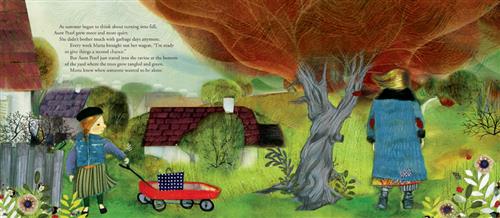Acclaimed author Monica Kulling brings sensitivity to this bittersweet portrayal of a loving family affected by homelessness, beautifully illustrated in Irene Luxbacher’s rich collage style.
Aunt Pearl arrives one day pushing a shopping cart full of her worldly goods. Her sister Rose has invited her to come live with her family.
Six-year-old Marta is happy to meet her aunt, who takes her out to look for treasure on garbage day, and who shows her camp group how to decorate a coffee table with bottle caps. But almost immediately, Pearl and Rose start to clash — over Pearl’s belongings crammed into the house, and over Rose’s household rules. As the weeks pass, Pearl grows quieter and more withdrawn, until, one morning, she is gone.
Acclaimed author Monica Kulling brings sensitivity to this story about homelessness, family and love, beautifully illustrated in Irene Luxbacher’s rich collage style.
Correlates to the Common Core State Standards in English Language Arts:
CCSS.ELA-LITERACY.RL.2.6
Acknowledge differences in the points of view of characters, including by speaking in a different voice for each character when reading dialogue aloud.
CCSS.ELA-LITERACY.RL.3.7
Explain how specific aspects of a text's illustrations contribute to what is conveyed by the words in a story (e.g., create mood, emphasize aspects of a character or setting)
Acclaimed author Monica Kulling brings sensitivity to this bittersweet portrayal of a loving family affected by homelessness, beautifully illustrated in Irene Luxbacher’s rich collage style.
Aunt Pearl arrives one day pushing a shopping cart full of her worldly goods. Her sister Rose has invited her to come live with her family.
Six-year-old Marta is happy to meet her aunt, who takes her out to look for treasure on garbage day, and who shows her camp group how to decorate a coffee table with bottle caps. But almost immediately, Pearl and Rose start to clash — over Pearl’s belongings crammed into the house, and over Rose’s household rules. As the weeks pass, Pearl grows quieter and more withdrawn, until, one morning, she is gone.
Acclaimed author Monica Kulling brings sensitivity to this story about homelessness, family and love, beautifully illustrated in Irene Luxbacher’s rich collage style.
Correlates to the Common Core State Standards in English Language Arts:
CCSS.ELA-LITERACY.RL.2.6
Acknowledge differences in the points of view of characters, including by speaking in a different voice for each character when reading dialogue aloud.
CCSS.ELA-LITERACY.RL.3.7
Explain how specific aspects of a text's illustrations contribute to what is conveyed by the words in a story (e.g., create mood, emphasize aspects of a character or setting)
| Published By | Groundwood Books Ltd — Aug 1, 2019 |
| Specifications | 32 pages | 10 in x 8.75 in |
| Keywords | homelessness; mental health; inclusivity; diversity; family and family issues; intergenerational friendships; compassion; acceptance; empathy; inclusive; respect for others; open ended conclusion; figurative language; metaphors; differing points of view; author studies; illustrator studies; Common Core aligned; grade 1; grade 2; grade 3; CC Literature Craft and Structure; CC Literature Integration of Knowledge and Ideas; picture book; collage style artwork; |
| Written By |
MONICA KULLING iis the author of more than sixty books for children, including Aunt Pearl, illustrated by Irene Luxbacher; and Ruby’s Hope: A Story of How the Famous “Migrant Mother” Photograph Became the Face of the Great Depression, illustrated by Sarah Dvojak. She has written the popular Great Idea series, and her work has been nominated for many awards, including numerous Silver Birch Express and Golden Oak awards and the Norma Fleck Award for Canadian Children’s Non-Fiction. She lives in Toronto, Ontario. |
| Illustrated by |
IRENE LUXBACHER is an artist and author living in Toronto, Ontario, who has received many awards for her work. She has written and illustrated Deep Underwater, an Elizabeth Mrazik-Cleaver Award finalist, and Mr. Frank, which was selected as a USBBY Outstanding International Book. Her illustrations for the Malaika series by Nadia L. Hohn have been highly acclaimed, and her illustrations for The Imaginary Garden by Andrew Larsen were shortlisted for the Governor General’s Literary Award. |
| Written By |
|
MONICA KULLING iis the author of more than sixty books for children, including Aunt Pearl, illustrated by Irene Luxbacher; and Ruby’s Hope: A Story of How the Famous “Migrant Mother” Photograph Became the Face of the Great Depression, illustrated by Sarah Dvojak. She has written the popular Great Idea series, and her work has been nominated for many awards, including numerous Silver Birch Express and Golden Oak awards and the Norma Fleck Award for Canadian Children’s Non-Fiction. She lives in Toronto, Ontario. |
| Illustrated by |
|
IRENE LUXBACHER is an artist and author living in Toronto, Ontario, who has received many awards for her work. She has written and illustrated Deep Underwater, an Elizabeth Mrazik-Cleaver Award finalist, and Mr. Frank, which was selected as a USBBY Outstanding International Book. Her illustrations for the Malaika series by Nadia L. Hohn have been highly acclaimed, and her illustrations for The Imaginary Garden by Andrew Larsen were shortlisted for the Governor General’s Literary Award. |
| Audience | ages 4 to 7 / grades K to 2 |
| Reading Levels |
Lexile AD540L
Fountas & Pinnel Text Level R Guided Reading R |
| Common Core |
CCSS.ELA-LITERACY.RL.2.6
CCSS.ELA-LITERACY.RL.3.7 |
Short-listed, IODE Jean Throop Book Award, 2020
Commended, Mighty Village Spring Book Picks, 2019
“A poignant look at a homeless woman and her family—a constellation too rarely seen.” — Kirkus Reviews
“[A] thoughtful, gentle starting point for discussion about mental health and homelessness.” — 49th Shelf Blog




